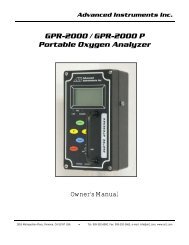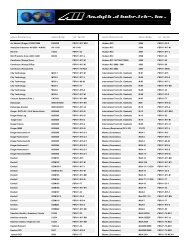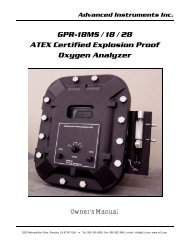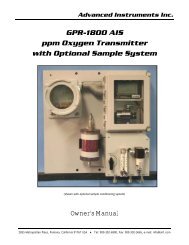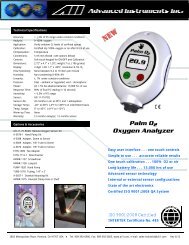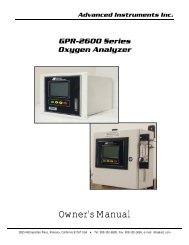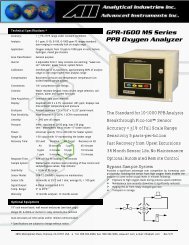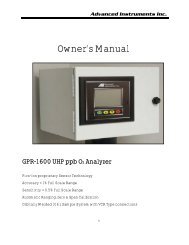GPR-1200 Portable ppm Oxygen Analyzer - Advanced Instruments Inc.
GPR-1200 Portable ppm Oxygen Analyzer - Advanced Instruments Inc.
GPR-1200 Portable ppm Oxygen Analyzer - Advanced Instruments Inc.
You also want an ePaper? Increase the reach of your titles
YUMPU automatically turns print PDFs into web optimized ePapers that Google loves.
drawn through metal tubing inside the analyzer. The internal sample system includes 1/8” compression inlet and vent fittings, astainless steel sensor housing with an o-ring seal to prevent the leakage of air and stainless steel tubing.Flow rates of 1-5 SCFH cause no appreciable change in the oxygen reading. However, flow rates above 5 SCFH generatebackpressure and erroneous oxygen readings because the diameter of the integral tubing cannot evacuate the sample gas atthe higher flow rate. The direction the sample gas flows is not important, thus either tube fitting can serve as the inlet or vent –just not simultaneously.A flow indicator with an integral metering valve upstream of the sensor is recommended as a means of controlling the flow rateof the sample gas. A flow rate of 2 SCFH or 1 liter per minute is recommended for optimum performance.Caution: Do not place your finger over the vent (it pressurizes the sensor) to test the flow indicator when gas is flowing to thesensor. Removing your finger (the restriction) generates a vacuum on the sensor and may damage the sensor (voiding thesensor warranty). To avoid generating a vacuum on the sensor (as described above) during operation, always select and installthe vent fitting first and remove the vent fitting last.Application Pressure - Positive: A flow indicator with integral metering valve positioned upstream of the sensor isrecommended for controlling the sample flow rate between 1-5 SCFH. To reduce the possibility of leakage for low <strong>ppm</strong>measurements, position a metering needle valve upstream of the sensor to control the flow rate and position a flow indicatordownstream of the sensor. If necessary, a pressure regulator (with a metallic diaphragm is recommended for optimumaccuracy, the use of diaphragms of more permeable materials may result in erroneous readings) upstream of the flow controlvalve should be used to regulate the inlet pressure between 5-30 psig.Caution: If the analyzer is equipped with a H2S scrubber as part of an optional sample conditioning system, inlet pressuremust not exceed 30 psig.Application Pressure - Atmospheric or Slightly Negative: For accurate <strong>ppm</strong> range oxygen measurements, an optionalexternal sampling pump should be positioned downstream of the sensor to draw the sample from the process, by the sensorand out to atmosphere. A flow meter is generally not necessary to obtain the recommended flow rate with most samplingpumps.Caution: If the analyzer is equipped with an optional flow indicator with integral metering valve or a metering flow controlvalve upstream of the sensor - open the metering valve completely to avoid drawing a vacuum on the sensor and placing anundue burden on the pump.If pump loading is a consideration, a second throttle valve on the pump’s inlet side may be necessary to provide a bypass pathso the sample flow rate is within the above parameters.Recommendations to avoid erroneous oxygen readings and damaging the sensor:‣ Do not place your finger over the vent (it pressurizes the sensor) to test the flow indicator when gas is flowing to thesensor. Removing your finger (the restriction) generates a vacuum on the sensor and may damage the sensor (thus voidingthe sensor warranty).‣ Assure there are no restrictions in the sample or vent lines‣ Avoid drawing a vacuum that exceeds 14” of water column pressure – unless done gradually‣ Avoid excessive flow rates above 5 SCFH which generate backpressure on the sensor.‣ Avoid sudden releases of backpressure that can severely damage the sensor.‣ Avoid the collection of liquids or particulates on the sensor, they block the diffusion of oxygen into the sensor - wipe away.‣ If the analyzer is equipped with an optional integral sampling pump (positioned downstream of the sensor) and a flowcontrol metering valve (positioned upstream of the sensor), completely open the flow control metering valve to avoiddrawing a vacuum on the sensor and placing an undue burden on the pump.6



